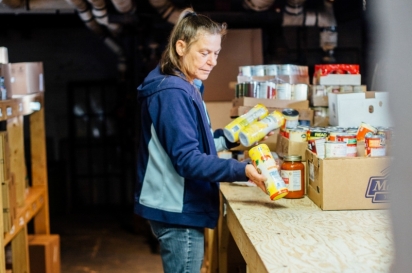The Food Pantries for the Capital District
Imagine trying to feed yourself on $4.50 a day. Without cheating. For most of us, that’s coffee and a treat. If you’re dependent on the monthly SNAP (Supplemental Nutrition Assistance Program) benefits, formerly known as food stamps, that $4.50 average daily allotment tends to run out by the third week. Take the “SNAP challenge” to experience why people living in a chronic food emergency often opt for cheap calories rather than healthful food. But for many, the emergency doesn’t end.
43,500 people visit Capital District food pantries annually. However, according to Feeding America, more than 80,000 people—including 23,000 babies and children—in our region are food insecure, which means they lack access or resources to provide healthy food on a consistent basis. That’s one in 10 citizens.
“The face of people who visit food pantries is changing,” says Natasha Pernicka, executive director of the Food Pantries for the Capital District since 2011. “We’ve become a supplemental food program, not just an emergency resource. Many families in need turn to food pantries on a monthly basis to supplement their grocery shopping. A government statistic says approximately 85% of families who rely on food assistance have at least one working parent. It’s become increasingly hard to feed a family on a wage of less than $15 an hour.”
Food pantries are not a government program; most function in churches, community centers and other nonprofit spaces and depend on legions of dedicated volunteers. “If someone shows up at a pantry in need of food, we provide for them,” Pernicka says. “We are proud that none of our pantries have had to turn away a hungry person due to lack of food supply.”
THE POWER OF COLLABORATION
In 1979, the Capital Area Council of Churches formed a coalition of 10 member food pantries. The group now encompasses 56 pantries in Albany, Rensselaer and Saratoga counties. Schenectady County will join the group in 2017. According to Pernicka, this coalition is the first of its kind in the U.S. The Food Pantries for the Capital District coordinates funding, purchasing, collecting and delivering food di- rectly to member pantries. A full 78% of the organization’s revenue comes from contributions, 12% from grants and the remaining 10% from fundraising efforts, with 21 major funding partners in the Capi- tal District providing generous support.
“Because we rely mostly on financial donations from corporations, foundations and individuals,” Pernicka explains, “we can be effective without getting bogged down in bureaucracy. We have the flexibility and creativity to work with the specific needs of each location. And we’re transparent, so people can see exactly how their dollars are being utilized.”
One dollar can provide up to 6.25 pounds of food. Pantries must provide food based on the My Plate model of grains, proteins, fruits and vegetables and dairy. Reliable funding helps ensure that the pan- tries remain fully stocked with a variety of nutritious foods.
A substantial percentage of the pantries’ food comes from the Regional Food Bank, a warehouse located on Albany-Shaker Road. That facility serves 23 counties and 1,000 organizations in New York State. Industrial racks packed with cases of dry goods stretch from concrete floor to corrugated ceiling. Pallets of stacked cardboard boxes shrouded in plastic wrap are shuttled into delivery trucks. Men whiz by on motorized pallet jacks and forklifts, beeping horns to warn pedestrians of their approach. Consider it the Amazon of low-cost or free food. Blue racks of sliced breads. Cereals, pasta, rice, canned soups, beans, vegetables, chili, tuna, fruits. Applesauce, pancake mix, condiments, cooking oils, drinks. Refrigerated storerooms of butter, eggs, cheese, dairy. Freezer bays of meats. In other words, the same stuff we all eat.
ALL ABOARD THE FOOD EXPRESS!
Since 2009, Lee Sweeney has driven the Food Express, a box truck that delivers daily 8,000 to 13,000 pounds of food from the Regional Food Bank to area pantries. Lee and his working partner, James Johnson, stop at approximately 25 pantries a week, and last year, they transport- ed more than 2.5 million pounds of food. James has been a volunteer for 22 years, the longest-term member of the Food Pantries team. The truck holds 10 fully loaded pallets, and James ensures that each pallet is stowed precisely and logically based on the order of delivery stops.
Another driver runs the bread truck. After picking up those blue racks of bread from the Food Bank, he makes stops all around the Albany area to pick up day-old bread products donated by local grocery stores and bakeries.
“The pantries’ need for food is greater than our capacity,” says Pernicka. “In January we are getting a second larger box truck, which will allow us to double our food-delivery capacity.”
A mobile food pantry serves the rural hill towns of Berne, Knox, Rensselaerville and Westerlo. The organization recently acquired a second-hand school bus that will transport food to outlying areas once the seats have been removed and shelves installed.
According to Angie Pender-Fox, program director for the Food Pantries, “Our members truly value the Food Express delivery system. This lifeline enables them to serve more people in their communities but also to be more efficient in their pantries with less strain on their wonderful volunteers.”
FILLING THE GAP
With the help of the University at Albany and Siena College, the Food Pantries coalition has developed a “Filling the Gap” study to assess the food pantries and the needs of their communities. This project analyzes the systems and tries to discern the barriers to food pantries, such as stigma, transportation, sites and hours of operation. “How do we market and reach people who are in need but don’t nec- essarily want to accept charity?” asks Pernicka. “If you are fed, you have better health and perform better in school or the workplace. It benefits everyone to have people in their community properly fed.”
Each pantry is unique and reflects their neighborhood. On delivery day, energetic volunteers shuttle the cases of food from the truck to restock the pantry shelves. Most deliveries average 2,500 pounds. Pantries receive deliveries up to four times per month, depending on need.
The St. James food pantry off Delaware Avenue in Albany functions in a former Catholic school classroom. Linda Cruz volunteered for 15 years before she became the director in 2014. “Our patrons pick up their food once a month but can come by for fresh bread and produce if it’s available anytime we’re open. We receive donations from St. Francis parishioners, the Boy Scout fund drive, the CANstruction food drive. Donating year-round also helps tremendously,” says Cruz.
Colleen Pidgeon volunteered for 19 years at CoNSERNS-U in Rensselaer before becoming program coordinator in 2008. Several converted classrooms in a former Catholic school now house a bustling food pantry and human resources center. “If you’re in need of food, you’re probably in need of something else,” Pidgeon says.
“We serve 340 households each month. Most are single-parent families. At the holidays, we assist more than 600 households. In August we gave 400 kids brand-new backpacks filled with new school supplies. We focus a lot on kids, try to give them the opportunity for as normal a life as possible. Come winter, we do a coat drive and people donate brand-new winter coats.”
The majority of volunteers are retired teachers, nurses and social workers. Pidgeon notes that “Since they’ve already spent a career in the helping professions, they possess the necessary nurturing skills.”
HOPE 7 serves 300 families on the east side of Troy and Wynantskill. “We’ve been at the Pawl- ing Avenue Methodist Church since 1988,” says Sherri Capparello, who runs the program. “We’re so fortunate to have volunteers from all walks of life, from retirees and college kids to people from the day-hab facility and ARC. I’ve never met such selfless individuals. We also have a number of local businesses and organizations who contribute to food and toy drives.”
One of the more rural sites operates out of the Presbyterian Church on Farm to Market Road in Brunswick. Holly and Bob Clarke have coordinat- ed the food pantry since it opened in 2009. “Being out in the country, we draw from quite a distance and serve about 55 families. People have access to the full pantry once a month and can get milk, eggs, produce and bread. We have a cadre of about 50 fantastic volunteers.”
RAISING AWARENESS
“Food is a basic necessity that many of us take for granted,” Natasha Pernicka says. “It’s incredibly stressful when you don’t know where your next meal is coming from, or how to feed your family. We believe that all people struggling with food insecu- rity should have access to the food they need. Our goal is to reduce barriers to food access and improve the resources of our local food pantry system. Raising awareness is crucial. When people hear about the sheer volume of food insecurity in our district, and numbers of people utilizing the food pantries here, they’re shocked. Fortunately, more and more people want to get involved as volunteers, and community support helps us achieve our vision.”
What drives this executive director? “I always wanted to help people. Simple as that. I’ve always worked at human service organizations because I believe that mental health, food, housing—that’s the platform for having a healthy life.”






